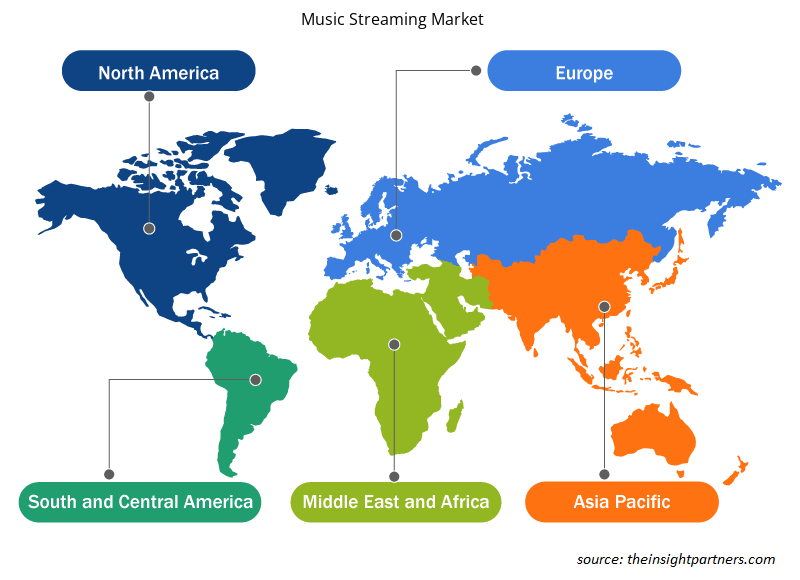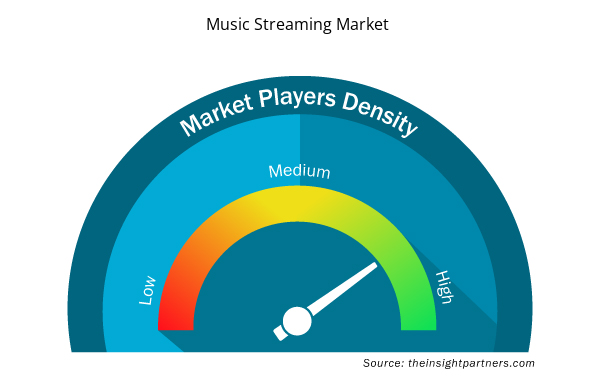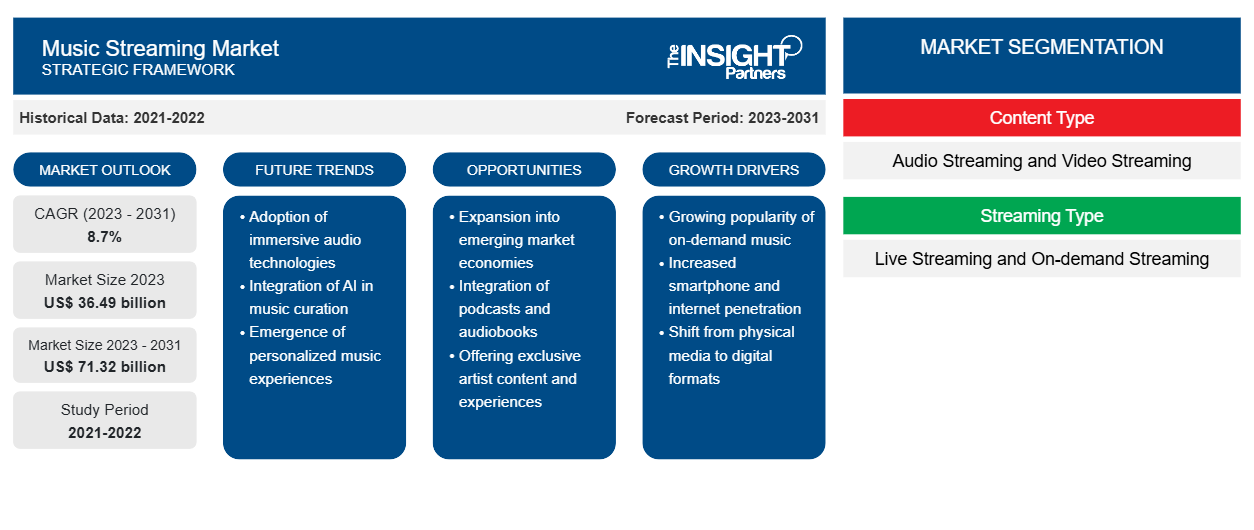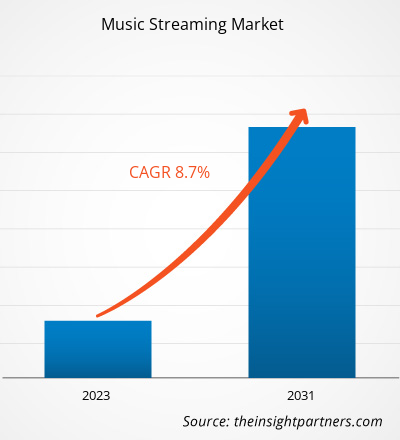Si prevede che il mercato dello streaming musicale raggiungerà i 71,32 miliardi di dollari entro il 2031, rispetto ai 36,49 miliardi di dollari del 2023. Si prevede che il mercato registrerà un CAGR dell'8,7% dal 2023 al 2031.
La crescente adozione della connettività 5G e la crescente domanda di streaming live di spettacoli musicali continueranno probabilmente a rappresentare una tendenza chiave nel mercato dello streaming musicale.
Analisi del mercato dello streaming musicale
Il mercato dello streaming musicale sta crescendo a un ritmo rapido a causa della crescente domanda di dispositivi compatibili con più dispositivi, della crescente adozione di piattaforme digitali e del crescente utilizzo di dispositivi intelligenti con accessibilità senza soluzione di continuità. Il mercato si sta espandendo costantemente, guidato dalla crescente attenzione degli operatori di mercato per migliorare l'esperienza del cliente fornendo abbonamenti senza pubblicità. Inoltre, la crescente adozione dello streaming musicale 3D online e l'integrazione di tecnologie avanzate, come AI e ML per migliorare l'esperienza di streaming della musica migliorando i consigli di ricerca, stanno offrendo opportunità redditizie per la crescita del mercato.
Panoramica del mercato dello streaming musicale
Lo streaming musicale è un metodo per distribuire contenuti audio, principalmente musica, ai dispositivi degli ascoltatori senza la necessità di scaricare file da Internet. Lo streaming musicale ha eliminato il processo di download e archiviazione di file musicali fornendo agli utenti l'accesso a un vasto elenco di brani tramite servizi di streaming. Questi servizi di streaming consentono agli utenti di ascoltare musica su una varietà di dispositivi, come smartphone, smart speaker, computer, tablet e altri, trasmettendo direttamente in streaming il contenuto audio tramite una connessione Internet.
Personalizza questo report in base alle tue esigenze
Riceverai la personalizzazione gratuita di qualsiasi report, comprese parti di questo report, o analisi a livello nazionale, pacchetto dati Excel, oltre a usufruire di grandi offerte e sconti per start-up e università
- Scopri le principali tendenze di mercato in questo rapporto.Questo campione GRATUITO includerà analisi di dati che spaziano dalle tendenze di mercato alle stime e alle previsioni.
Driver e opportunità del mercato dello streaming musicale
La crescente domanda di dispositivi compatibili con più dispositivi sta guidando il mercato
La crescente digitalizzazione, il progresso tecnologico e la crescente adozione di tecnologie avanzate per la distribuzione di musica in formato digitale incoraggiano i produttori a sviluppare dispositivi compatibili con più dispositivi per soddisfare le esigenze dei propri clienti. La crescente domanda di diversi tipi di dispositivi compatibili con più dispositivi, come smartphone, smart speaker , TV HD, smartwatch e vari dispositivi di assistenza vocale, tra cui Amazon Alexa, Apple Siri, Microsoft Cortana e Samsung Bixby, sta guidando il mercato. Ciò aumenta l'attenzione degli operatori di mercato per offrire dispositivi compatibili con più dispositivi per fornire agli utenti una migliore esperienza di ascolto. Gli utenti in tutto il mondo stanno adottando ampiamente i dispositivi compatibili con più dispositivi come un'opzione di intrattenimento efficace. Inoltre, il crescente numero di ascoltatori di musica e abbonati alle app sta alimentando il mercato.
Crescente adozione dello streaming musicale 3D online: un'opportunità nel mercato dello streaming musicale
L'introduzione di sistemi digitali e cloud aumenta l'adozione di piattaforme di streaming on-demand e streaming musicale. Questi sviluppi consentono ai creatori di contenuti musicali di fornire ai propri abbonati tramite un modello di abbonamento, con un impatto significativo nello sviluppo di elenchi di brani audio 3D e piattaforme di streaming musicale. I fornitori di servizi di streaming musicale offrono musica audio 3D per attrarre un'enorme base di clienti aumentando il numero di abbonamenti. Anche la crescente domanda di app di streaming musicale sta creando opportunità nel mercato. Ad esempio, l'India sta diventando un hub per i fornitori di contenuti musicali e la facile disponibilità di app di streaming musicale come Amazon Prime, Gaana.com e Saawan.com consente ai fornitori di contenuti musicali di offrire un elenco di brani 3D agli ascoltatori.
Analisi della segmentazione del rapporto sul mercato dello streaming musicale
I segmenti chiave che hanno contribuito alla derivazione dell'analisi del mercato dello streaming musicale sono il tipo di contenuto, il tipo di streaming e l'utente finale.
- In base al tipo di contenuto, il mercato dello streaming musicale è diviso in streaming audio e streaming video. Il segmento dello streaming audio ha detenuto una quota di mercato maggiore nel 2023.
- In termini di tipo di streaming, il mercato dello streaming musicale è diviso in streaming live e streaming on-demand. Il segmento dello streaming on-demand ha detenuto una quota di mercato maggiore nel 2023.
- Sulla base dell'utente finale, il mercato è segmentato in commerciale e individuale. Il segmento individuale ha detenuto la quota maggiore del mercato nel 2023.
Analisi della quota di mercato dello streaming musicale per area geografica
L'ambito geografico del rapporto sul mercato dello streaming musicale è suddiviso principalmente in cinque regioni: Nord America, Asia Pacifico, Europa, Medio Oriente e Africa e Sud America/Sud e Centro America.
In termini di fatturato, il Nord America ha rappresentato la quota di mercato più grande dello streaming musicale, con la presenza di attori chiave tra cui Amazon, Inc., Apple Inc., Pandora Media, Inc. e Spotify Tidal, tra gli altri. Questi attori sono costantemente impegnati nell'offrire soluzioni di streaming audio e video di alta qualità agli ascoltatori. Il crescente utilizzo delle piattaforme di social media e lo sviluppo di app di analisi degli artisti stanno creando opportunità nel mercato.
Notizie e sviluppi recenti sul mercato dello streaming musicale
Il mercato dello streaming musicale viene valutato raccogliendo dati qualitativi e quantitativi dopo la ricerca primaria e secondaria, che include importanti pubblicazioni aziendali, dati associativi e database. Di seguito è riportato un elenco degli sviluppi nel mercato dello streaming musicale e delle strategie:
- A febbraio 2024, Spotify ha pagato 9,0 miliardi di dollari all'industria musicale. Questo pagamento include i guadagni distribuiti ai titolari dei diritti e agli artisti. (Fonte: Spotify, Comunicato stampa, 2024)
- A novembre 2022, Amazon Music ha ampliato la sua offerta per i membri Prime, offrendo loro un catalogo completo di 100 milioni di brani e i migliori podcast disponibili senza pubblicità e senza costi aggiuntivi per il loro abbonamento. (Fonte: Amazon, Inc., Comunicato stampa, 2022)
Approfondimenti regionali sul mercato dello streaming musicale
Le tendenze regionali e i fattori che influenzano il mercato dello streaming musicale durante il periodo di previsione sono stati ampiamente spiegati dagli analisti di Insight Partners. Questa sezione discute anche i segmenti e la geografia del mercato dello streaming musicale in Nord America, Europa, Asia Pacifico, Medio Oriente e Africa e America centrale e meridionale.

- Ottieni i dati specifici regionali per il mercato dello streaming musicale
Ambito del rapporto sul mercato dello streaming musicale
| Attributo del report | Dettagli |
|---|---|
| Dimensioni del mercato nel 2023 | 36,49 miliardi di dollari USA |
| Dimensioni del mercato entro il 2031 | 71,32 miliardi di dollari USA |
| CAGR globale (2023-2031) | 8,7% |
| Dati storici | 2021-2022 |
| Periodo di previsione | 2023-2031 |
| Segmenti coperti | Per tipo di contenuto
|
| Regioni e Paesi coperti | America del Nord
|
| Leader di mercato e profili aziendali chiave |
|
Densità dei player del mercato dello streaming musicale: comprendere il suo impatto sulle dinamiche aziendali
Il mercato dello streaming musicale sta crescendo rapidamente, spinto dalla crescente domanda degli utenti finali dovuta a fattori quali l'evoluzione delle preferenze dei consumatori, i progressi tecnologici e una maggiore consapevolezza dei vantaggi del prodotto. Con l'aumento della domanda, le aziende stanno ampliando le loro offerte, innovando per soddisfare le esigenze dei consumatori e capitalizzando sulle tendenze emergenti, il che alimenta ulteriormente la crescita del mercato.
La densità degli operatori di mercato si riferisce alla distribuzione di aziende o società che operano in un particolare mercato o settore. Indica quanti concorrenti (operatori di mercato) sono presenti in un dato spazio di mercato in relazione alle sue dimensioni o al valore di mercato totale.
Le principali aziende che operano nel mercato dello streaming musicale sono:
- Amazon, Inc.
- Società per azioni Apple Inc.
- Deezer
- Google Inc.
- iheartmedia, Inc.
- Gioia
Disclaimer : le aziende elencate sopra non sono classificate secondo un ordine particolare.

- Ottieni una panoramica dei principali attori del mercato dello streaming musicale
Copertura e risultati del rapporto sul mercato dello streaming musicale
Il rapporto “Dimensioni e previsioni del mercato dello streaming musicale (2023-2031)” fornisce un’analisi dettagliata del mercato che copre le seguenti aree:
- Dimensioni e previsioni del mercato a livello globale, regionale e nazionale per tutti i segmenti di mercato chiave coperti dall'ambito
- Dinamiche di mercato come fattori trainanti, vincoli e opportunità chiave
- Principali tendenze future
- Analisi dettagliata delle cinque forze PEST/Porter e SWOT
- Analisi di mercato globale e regionale che copre le principali tendenze di mercato, i principali attori, le normative e gli sviluppi recenti del mercato
- Analisi del panorama industriale e della concorrenza che copre la concentrazione del mercato, l'analisi della mappa di calore, i principali attori e gli sviluppi recenti
- Profili aziendali dettagliati
- Analisi storica (2 anni), anno base, previsione (7 anni) con CAGR
- Analisi PEST e SWOT
- Valore/volume delle dimensioni del mercato - Globale, regionale, nazionale
- Industria e panorama competitivo
- Set di dati Excel



Report Coverage
Revenue forecast, Company Analysis, Industry landscape, Growth factors, and Trends

Segment Covered
This text is related
to segments covered.

Regional Scope
North America, Europe, Asia Pacific, Middle East & Africa, South & Central America

Country Scope
This text is related
to country scope.
Domande frequenti
The growing demand for multi-device compatibility devices, increasing adoption of digital platforms, and growing utilization of smart devices with seamless accessibility are the major factors that propel the global music streaming market.
The global music streaming market was estimated to be US$ 36.49 billion in 2023 and is expected to grow at a CAGR of 8.7% during the forecast period 2023 - 2031.
The rising adoption of 5G connectivity and the growing demand for live streaming of music shows are anticipated to play a significant role in the global music streaming market in the coming years.
The key players holding majority shares in the global music streaming market are Amazon, Inc., Apple Inc., Deezer, Google Inc., and iheartmedia, Inc.
The global music streaming market is expected to reach US$ 71.32 billion by 2031.
The incremental growth expected to be recorded for the global music streaming market during the forecast period is US$ 34.83 billion.
Trends and growth analysis reports related to Technology, Media and Telecommunications : READ MORE..
- Amazon, Inc.
- Apple Inc.
- Deezer
- Google Inc.
- iheartmedia, Inc.
- Joox
- Pandora Media, Inc.
- SoundCloud
- Spotify
- Tidal
The Insight Partners performs research in 4 major stages: Data Collection & Secondary Research, Primary Research, Data Analysis and Data Triangulation & Final Review.
- Data Collection and Secondary Research:
As a market research and consulting firm operating from a decade, we have published and advised several client across the globe. First step for any study will start with an assessment of currently available data and insights from existing reports. Further, historical and current market information is collected from Investor Presentations, Annual Reports, SEC Filings, etc., and other information related to company’s performance and market positioning are gathered from Paid Databases (Factiva, Hoovers, and Reuters) and various other publications available in public domain.
Several associations trade associates, technical forums, institutes, societies and organization are accessed to gain technical as well as market related insights through their publications such as research papers, blogs and press releases related to the studies are referred to get cues about the market. Further, white papers, journals, magazines, and other news articles published in last 3 years are scrutinized and analyzed to understand the current market trends.
- Primary Research:
The primarily interview analysis comprise of data obtained from industry participants interview and answers to survey questions gathered by in-house primary team.
For primary research, interviews are conducted with industry experts/CEOs/Marketing Managers/VPs/Subject Matter Experts from both demand and supply side to get a 360-degree view of the market. The primary team conducts several interviews based on the complexity of the markets to understand the various market trends and dynamics which makes research more credible and precise.
A typical research interview fulfils the following functions:
- Provides first-hand information on the market size, market trends, growth trends, competitive landscape, and outlook
- Validates and strengthens in-house secondary research findings
- Develops the analysis team’s expertise and market understanding
Primary research involves email interactions and telephone interviews for each market, category, segment, and sub-segment across geographies. The participants who typically take part in such a process include, but are not limited to:
- Industry participants: VPs, business development managers, market intelligence managers and national sales managers
- Outside experts: Valuation experts, research analysts and key opinion leaders specializing in the electronics and semiconductor industry.
Below is the breakup of our primary respondents by company, designation, and region:

Once we receive the confirmation from primary research sources or primary respondents, we finalize the base year market estimation and forecast the data as per the macroeconomic and microeconomic factors assessed during data collection.
- Data Analysis:
Once data is validated through both secondary as well as primary respondents, we finalize the market estimations by hypothesis formulation and factor analysis at regional and country level.
- Macro-Economic Factor Analysis:
We analyse macroeconomic indicators such the gross domestic product (GDP), increase in the demand for goods and services across industries, technological advancement, regional economic growth, governmental policies, the influence of COVID-19, PEST analysis, and other aspects. This analysis aids in setting benchmarks for various nations/regions and approximating market splits. Additionally, the general trend of the aforementioned components aid in determining the market's development possibilities.
- Country Level Data:
Various factors that are especially aligned to the country are taken into account to determine the market size for a certain area and country, including the presence of vendors, such as headquarters and offices, the country's GDP, demand patterns, and industry growth. To comprehend the market dynamics for the nation, a number of growth variables, inhibitors, application areas, and current market trends are researched. The aforementioned elements aid in determining the country's overall market's growth potential.
- Company Profile:
The “Table of Contents” is formulated by listing and analyzing more than 25 - 30 companies operating in the market ecosystem across geographies. However, we profile only 10 companies as a standard practice in our syndicate reports. These 10 companies comprise leading, emerging, and regional players. Nonetheless, our analysis is not restricted to the 10 listed companies, we also analyze other companies present in the market to develop a holistic view and understand the prevailing trends. The “Company Profiles” section in the report covers key facts, business description, products & services, financial information, SWOT analysis, and key developments. The financial information presented is extracted from the annual reports and official documents of the publicly listed companies. Upon collecting the information for the sections of respective companies, we verify them via various primary sources and then compile the data in respective company profiles. The company level information helps us in deriving the base number as well as in forecasting the market size.
- Developing Base Number:
Aggregation of sales statistics (2020-2022) and macro-economic factor, and other secondary and primary research insights are utilized to arrive at base number and related market shares for 2022. The data gaps are identified in this step and relevant market data is analyzed, collected from paid primary interviews or databases. On finalizing the base year market size, forecasts are developed on the basis of macro-economic, industry and market growth factors and company level analysis.
- Data Triangulation and Final Review:
The market findings and base year market size calculations are validated from supply as well as demand side. Demand side validations are based on macro-economic factor analysis and benchmarks for respective regions and countries. In case of supply side validations, revenues of major companies are estimated (in case not available) based on industry benchmark, approximate number of employees, product portfolio, and primary interviews revenues are gathered. Further revenue from target product/service segment is assessed to avoid overshooting of market statistics. In case of heavy deviations between supply and demand side values, all thes steps are repeated to achieve synchronization.
We follow an iterative model, wherein we share our research findings with Subject Matter Experts (SME’s) and Key Opinion Leaders (KOLs) until consensus view of the market is not formulated – this model negates any drastic deviation in the opinions of experts. Only validated and universally acceptable research findings are quoted in our reports.
We have important check points that we use to validate our research findings – which we call – data triangulation, where we validate the information, we generate from secondary sources with primary interviews and then we re-validate with our internal data bases and Subject matter experts. This comprehensive model enables us to deliver high quality, reliable data in shortest possible time.


 Ottieni un campione gratuito per questo repot
Ottieni un campione gratuito per questo repot